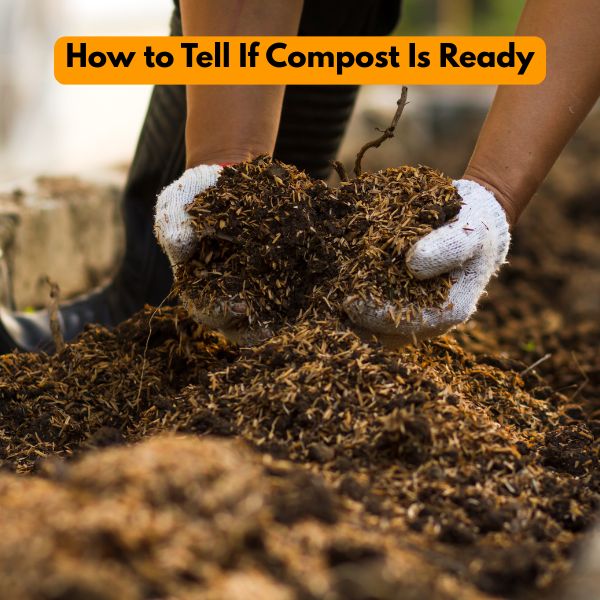Simple Signs for Perfect Home Composting
Composting turns kitchen scraps and garden clippings into a rich, dark material that does wonders for your plants.
Whether you’re piling up leaves in the corner or using a compost tumbler, the process is all about recycling organic waste and making your garden healthier while helping the planet.
Home composting matters because it cuts down on waste, saves money on fertilizer, and boosts your soil’s nutrients.
Even kids can get the hang of it, especially with fun methods like vermicomposting (using worms to break food down).
But how can you tell if compost is ready to use? The answer is straightforward—finished compost is dark, crumbly, smells earthy, and blends right in with the soil.
Using compost that’s actually finished leads to stronger plants and a healthier garden. If you want extra tips on handling small spaces, check out advice for making compost in small garden.
By learning to spot the simple signs of ready compost, you’ll support your plants, your wallet, and the environment all at once.
What Is Composting and Why It Matters
Composting is more than just tossing scraps into a pile and hoping for the best. It’s the natural process where kitchen leftovers, yard clippings, and even the peels you might normally throw away are transformed into something that looks like rich, dark soil.
This material—called compost—acts as a nutrient-packed boost for plants, helping them grow strong and healthy without chemical fertilizers.
Home composting, whether you use a compost tumbler, open heap, or jump into vermicomposting with worms, is simple, rewarding, and good for the planet.
Let’s break down the what and why before getting into how to tell if compost is ready for your garden.
 Compost thermometers are essential if you take composting seriously
Compost thermometers are essential if you take composting seriously
Composting: Turning Waste Into Gold
When you compost, you help nature recycle. Bacteria, fungi, and tiny insects in your compost bin or pile break down food scraps and plant trimmings.
Over several weeks or months, what started as waste turns into a fine, crumbly material you can add right back into your garden soil.
This finished compost is the real “black gold” for gardeners.
Some common ways people compost at home include:
- Using a compost tumbler for faster mixing and breakdown.
- Creating a backyard heap or pile.
- Trying worm composting, known as vermicomposting, for compact and efficient results.
For a clear overview of several popular composting styles, check out these 6 Effective Composting Methods.
Each method has its perks, but all help you use kitchen and yard waste rather than tossing it out.
Why Composting Is Worth the Effort
Sure, composting saves money on fertilizer, but its benefits stretch beyond your garden.
Here’s why composting is a smart, easy habit for any household:
- Reduces landfill waste. Composting diverts food scraps and yard debris from the rubbish bin, which would otherwise give off methane in landfills.
- Supports healthy soil. Finished compost feeds soil life and improves its texture, helping plants grow better.
- Lowers your carbon footprint. Keeping organic material out of landfills means less harmful gas released into the air.
- Saves water. Compost holds moisture in the soil, so you water your plants less.
Think composting is only for people with big gardens? Not at all. Even a tiny balcony or flat can benefit from a small compost tumbler or a worm bin.
Need more ideas for making the most out of your kitchen scraps?
See how to reduce waste with composting and save even more from the bin.
Composting Methods Explained
Not every compost pile is the same. Each approach—traditional, tumbler, or vermicomposting—offers something different:
- Compost Tumbler: Speeds up the process with easy mixing and less mess.
- Traditional Pile: Great if you have a little extra space outside.
- Vermicomposting: Worms munch through scraps, making compost fast and with less odor—a perfect fit for indoors or small gardens.
For beginners, don’t worry about doing it perfectly.
The key is to get started, keep adding both “greens” (food scraps) and “browns” (leaves, paper), and let nature do its job.
Why Knowing When Compost Is Ready Matters
How to tell if compost is ready? It’s a question every composting fan eventually asks.
Using finished compost is a bit like checking if a cake is fully baked—you want it to be just right before you add it to your garden.
Spreading compost that’s not done yet can rob soil of nutrients or even harm young plants.
Here’s what finished compost should look and smell like:
- Looks like dark, crumbly soil—no big chunks or obvious food bits.
- Smells earthy and clean, not rotten or sour.
- Feels moist, but not soggy or slimy.
- Warms up and then cools down at the end of the process.
For practical, seasonal advice about managing your compost and knowing when it’s ready, take a look at these composting calendar tips. Timing varies with method and weather, but the clues are the same.
With this knowledge, you’ll know exactly when to scoop out that “black gold” and help your garden thrive.
Composting doesn’t just cut waste—it circles life’s leftovers right back into your soil, making everything greener, happier, and more sustainable.
How to Tell If Compost Is Ready: Signs to Look For
When your compost nears the finish line, it can be tempting to use it right away. But it pays to check carefully before you scoop it onto your garden beds or houseplants.
Mature compost works wonders for your soil—but unfinished compost can attract pests or lock up nitrogen that plants need.
Here’s how to tell if compost is ready to use, so you know you’re giving your plants the very best.
Color and Texture: The Look of Finished Compost
A heap of fully ready compost looks different from a pile that’s still decomposing. The transformation is dramatic.
What started as food scraps, wilted leaves, and yard debris turns into something that could easily be mistaken for soil in a healthy forest.
- Dark Brown or Black Color: Finished compost is deep brown or nearly black, showing that organic materials broke down completely.
- Crumbly Texture: It should fall apart easily in your hands, like rich coffee grounds or loose cake crumbs.
- Earthy Appearance: There shouldn’t be visible food scraps, twigs, or unrotted leaves. If you spot eggshells, big mulch pieces, or orange peels, give it more time.
Ready compost blends easily into soil and doesn’t have chunks of last week’s dinner.
If you want more visual cues, this helpful guide summarizes what makes compost finished.
 Photo by hans middendorp
Photo by hans middendorp
Smell Test: Does It Smell Earthy or Off?
The nose knows! Smell is one of the fastest ways to decide how to tell if compost is ready.
- Earthy Scent: Finished compost smells fresh and earthy, sort of like a forest floor after rain. This clean scent means microbes completed their work.
- No Strong Odors: If your pile smells sour, rotten, or like ammonia, it’s not ready yet. These off odors signal materials are still breaking down, or something in the mix—too many food scraps, perhaps—needs to be balanced.
- Trust Your Senses: If you hesitate before taking a whiff, your compost may need more time or a few simple fixes.
For a second opinion, you can always ask other composters or check handy troubleshooting guides, such as the Compost Charm question and answer tool for more tips.
Feeling the Difference: Moisture and Temperature Clues
Touch and temperature are equally important to test compost maturity.
Here’s what to feel for as you scoop in:
- Moist but Not Wet: Grab a handful of compost. It should feel like a wrung-out sponge—damp but not dripping. If it’s dry, add a little water. If soggy, turn the pile to boost air flow.
- Cool or Ambient Temperature: Mature compost is no longer hot. The breakdown process heats up the pile, often making it surprisingly warm inside. Once the heat drops to match air temperature, and stays there, your compost is done.
- Handles Easily: Good compost never feels sticky or slimy. It holds together lightly and crumbles apart.
Throughout the year, compost takes different amounts of time depending on weather and method—like using a compost tumbler in summer versus a backyard pile in winter.
For practical, seasonal advice about managing moisture, turning frequency, and when to expect finished compost, check the composting calendar guide.
You’ll find tips tailored for every season, which can make a big difference in how quickly your compost matures.
For even more strategies, see tips on composting during summertime.
Troubleshooting: What If Your Compost Isn’t Ready Yet?
Sometimes compost doesn’t finish as fast as you expect.
If you see lots of scraps, it smells off, or stays warm for weeks, don’t worry—almost every composter runs into this at some point.
Common reasons compost isn’t ready:
- Too little air (not enough turning).
- Pile is too dry or wet.
- Too many “greens” (food scraps, grass) or “browns” (leaves, paper) out of balance.
What you can do:
- Turn or aerate the pile more often to add oxygen.
- Adjust mix: If it’s slimy, add dry brown materials. If it’s dry, stir in water or green material.
- Chop up large pieces to help them break down faster.
If you want faster compost, a compost tumbler can speed things up with easy blending, or you can explore multiple composting methods to see what fits your needs.
If you find traditional piles are slow and you want something suited for indoors or tight spots, vermicomposting (using worms) is another speedy, low-odor choice.
Don’t be discouraged if your compost needs more time. Each batch is a fresh chance to recycle, learn, and get a little better.
With these simple checks, you’ll soon spot when your compost is perfectly ready for your garden.
Tips for Speeding Up the Composting Process
Composting can test your patience, especially when you’re eager to see that earthy, crumbly goodness in your garden beds. Luckily, you don’t need to wait forever.
With a few practical strategies, you can nudge your compost along and get finished results quicker—whether you’re working a simple heap, a compost tumbler, or even trying your hand at vermicomposting.
Speeding up the process doesn’t mean rushing nature, but it does mean making your pile as inviting as possible for the real composting champions: microbes and worms.
Turning and Mixing for Fast Results
 Photo by Dino
Photo by Dino
Oxygen is the fuel microbes need to break down your kitchen scraps and garden waste fast.
When your compost pile feels sluggish, a good turn with a fork or shovel brings in fresh air and wakes up all those decomposers.
Frequent turning—about once a week—keeps the process moving and helps everything break down evenly.
If you want a shortcut, a compost tumbler is your friend. It makes aeration as simple as spinning a barrel.
This tool reduces the mess and effort of traditional piles and can help produce ready compost in as little as a few weeks during warmer months. Just load it, spin every few days, and watch as your scraps transform more quickly.
Compost tumblers also keep things tidier and are perfect if you’re tight on space or want less bending and lifting.
Managing Greens and Browns: The Ideal Mix
Think of your compost like a recipe. You need both “greens” (wet, nitrogen-rich stuff) and “browns” (dry, carbon-rich stuff) for a balanced meal that microbes love.
- Greens: Fresh grass clippings, vegetable peels, coffee grounds, and even leftovers from vermicomposting provide nitrogen, which jumpstarts the breakdown.
- Browns: Dry leaves, shredded cardboard, sawdust, and twigs add the carbon microbes need for energy and structure.
For quick composting, aim for about 2 to 3 parts browns for every 1 part greens by volume. A good way to check?
The pile should always look moist but never slimy, and you shouldn’t smell anything unpleasant. If it starts to stink, you may have too many greens—toss in more browns, mix, and let microbes catch up.
Getting the ratio right is one of the most important secrets to success. Looking for detailed, beginner-friendly guidance?
The guide to starting composting at home has a straightforward breakdown of materials and steps.
Moisture and Temperature Monitoring
Moisture and temperature are the heartbeat and thermostat of your compost pile.
Too dry, and microbes nap. Too soggy, and things go anaerobic (stinky and slow).
To check moisture, grab a handful of composting mix and squeeze. It should feel like a wrung-out sponge—damp but not dripping.
If it’s too dry, water lightly. If it’s wet and mucky, mix in more browns and turn it well. Your nose will also tell you if things are out of balance—no sour or ammonia smells should be present.
Temperature tells you how active your compost is. During active phases, the pile gets warm—sometimes even steamy!
If you have a compost thermometer, aim for 40-60°C (104-140°F) in the middle. No thermometer?
Just stick your hand inside: it should feel warm but not burning. As the heap cools down, you’re much closer to being ready—this ties back to the main idea of how to tell if compost is ready.
Want to be a compost detective through the seasons? The composting calendar guide has month-by-month advice for keeping your pile healthy no matter the weather.
Bonus Tip: If you want more creative and in-depth suggestions, check out this handy resource on fast composting methods and tricks for all kinds of piles and bins.
With these small but important shifts in your routine, you’ll be amazed at how fast your compost comes together.
Every batch teaches you something new—keep mixing, balancing, and checking, and soon your patience will pay off with rich, garden-ready compost.
Summary and Further Support: Compost Readiness Made Simple
Getting your compost just right doesn’t have to feel like complicated science.
Once you get familiar with key signs—texture, color, smell, and temperature—you’ll know exactly how to tell if compost is ready for your garden or houseplants.
When in doubt, a little patience lets nature do the rest. Composting, whether you use a pile, a compost tumbler, or try vermicomposting, rewards you with rich soil and a happier, greener home.
If you ever feel stuck or curious about specific situations, there’s easy, friendly help available from the composting community and handy online resources.
FAQ: Your Composting Questions Answered
Let’s clear up some of the questions new and seasoned composters often have about readiness, possible problems, and unusual composting scenarios.
How long does compost take to be ready?
Most home compost bins or piles take between 3 and 12 months to finish, depending on what you add, your local weather, how often you turn the pile, and the composting method.
A compost tumbler often works a bit faster since it mixes materials well. Vermicomposting with worms can finish a batch in as little as 2-3 months under the right conditions.
Can I use unfinished compost?
It’s best to wait until your compost looks dark and crumbly with an earthy smell. Using it earlier may tie up nutrients in the soil and attract pests.
If you’re eager, unfinished compost can be spread in autumn so it continues breaking down over winter before planting season.
What should I do if my compost smells bad?
Strong odors usually mean there’s too much moisture or too many “greens” like food scraps. To fix a smelly bin, add dry materials such as leaves or shredded cardboard, and turn your pile more often. Regular mixing helps air out your compost and prevent stinky spots—learn easy steps from these compost mixing frequency tips.
Do I need to do anything special with my compost in winter?
Composting slows in cold weather but doesn’t stop completely. Keep feeding your bin, chop scraps smaller, and insulate the pile with extra leaves or straw.
Tumblers can be moved to a sheltered spot for better results. For more detailed advice on keeping your compost going all year, check out practical composting calendar tips.
Can I compost unusual things like citrus peels, coffee filters, or “compostable” plastics?
Most fruit and veg scraps are fine, but some materials break down slowly or can unbalance the mix. Small amounts of citrus, chopped thin, are safe.
Coffee filters and tea bags can go in, but check for plastic content. Yard waste, eggshells, and even some paper are welcome. “Compostable” plastics may only break down in commercial systems, not home bins—check packaging for details.
For more material-specific guidance, articles like How to Know if Your Compost is Ready offer plain explanations.
If you find yourself stuck or curious about a composting question not covered here, get instant, friendly guidance anytime with the Ask a Composting Question bot.
This tool will help you troubleshoot problems or get custom tips for your compost, compost tumbler, or worm bin, right when you need it.
Embracing the basics of how to tell if compost is ready gives you a confident path to healthy soil—and if you need a nudge in the right direction, there’s always a friendly answer nearby.

Photo by Julia M Cameron
Conclusion
Learning how to tell if compost is ready gives you the confidence to boost your garden, houseplants, or even your window box.
Now you know to look for that rich, earthy smell, dark and crumbly texture, and a cool pile—compost that’s truly finished.
Whether you’ve reached this point with a classic heap, a compost tumbler, or through vermicomposting, you can trust your homemade compost to nurture your soil and plants.
Put your new composting skills to use in the garden, and don’t forget, each season brings its own set of tips and challenges.
For extra advice on using your compost all year, check out seasonal ideas for keeping compost worms active in cold weather or get creative with a DIY trash can composter guide.
You’ve got everything you need to spot compost readiness and start reaping the rewards.
Happy composting and thanks for helping your world grow greener, one pile at a time!





